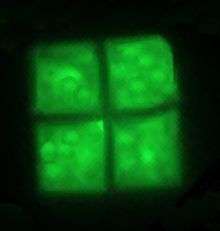Haloquadratum
| Haloquadratum | |
|---|---|
 | |
| Scientific classification | |
| Domain: | Archaea |
| Kingdom: | Euryarchaeota |
| Phylum: | Euryarchaeota |
| Class: | Halobacteria |
| Order: | Halobacteriales |
| Family: | Halobacteriaceae |
| Genus: | Haloquadratum Burns et al. 2007 |
| Species | |
Haloquadratum is a halophilic genus of the family Halobacteriaceae.[1] The first species to be identified in this group, Haloquadratum walsbyi, is unusual in that its cells are shaped like flat, square boxes.[2]
This archaean, discovered in 1980 by A.E. Walsby in the Gavish Sabkha, a coastal brine pool on the Sinai Peninsula in Egypt, was not cultured until 2004.[3]
The cells typically contain polyhydroxyalkanoate (PHA) granules, as well as large numbers of refractile, gas-filled vacuoles which provide buoyancy in a watery environment and may help to position the cells to maximise light-harvesting.[4] The cells may join with others to form fragile sheets up to 40 micrometres wide.
H. walsbyi can be found anywhere in hypersaline waters. When sea water evaporates, high concentration and precipitation of calcium carbonate and calcium sulphate result, leading to a hypersaline sodium chloride-rich brine. Further evaporation results in the precipitation of sodium chloride or halite, and then to a concentrated magnesium chloride brine termed bittern. During the final stage of halite formation, before magnesium chloride concentration causes the brine to become sterile, H. walsbyi flourishes and can make up 80% of the brine's biomass.
Description and significance
H. walsbyi was first discovered in 1980 by A.E. Walsby in the Gavish Sabkha, a coastal brine pool in the Sinai peninsula, Egypt, and formally described by Burns et al. in 2007.[3] The organisms were notable because of their extremely thin (around 0.15 μm), square-shaped structure. It was not cultivated in the lab until 2004.
Genome structure
The mapping of H. walsbyi's genome has been completed, giving a better understanding of the organism's genealogy and taxonomy, and the role it plays in the ecosystem.[5] A genomic comparison of the Spanish and Australian isolates (strains HBSQ001 and C23T) strongly suggests a rapid global dispersion, as they are so similar and have retained gene order (synteny).[6]
Cell structure and metabolism
H.walsbyi has a unique cell shape – that of an extremely thin square, its best-known characteristic. The cells possess an abundance of intracellular refractile bodies known as gas vacuoles – vacuoles filled with gas which provide buoyancy – maintaining upper position in the water column. Individual square cells are joined with others to form large sheets, sometimes as large as 40 µm. These sheets are extremely fragile and the connections between the cells are easily broken.
Its mode of metabolism is not completely known; complete genetic information will give researchers necessary insight.
Ecology
H. walsbyi was first noticed and taken from saline pools in Egypt, but it can be found in hypersaline bodies of water all over the world. Evaporation of water in these pools leaves high concentrations of salt, making for its optimal growth environment. According to Bolhuis et al., "In this sense, they are the most hyperhalophilic organisms known, as further concentration of the magnesium salts (bitterns) leads to sterility of the brines." Its precise role in the ecosystem is not known for sure, but because of its unique morphology, learning more about it will surely provide some information on the evolution and morphological adaptation of archaeans.
References
- ↑ See the NCBI webpage on Haloquadratum. Data extracted from the "NCBI taxonomy resources". National Center for Biotechnology Information. Retrieved 2007-03-19.
- ↑ Stoeckenius W (1 October 1981). "Walsby's square bacterium: fine structure of an orthogonal procaryote". J. Bacteriol. 148 (1): 352–60. PMC 216199. PMID 7287626.
- 1 2 Burns, D. G.; Janssen, P. H.; Itoh, T.; Kamekura, M.; Li, Z.; Jensen, G.; Rodriguez-Valera, F.; Bolhuis, H.; Dyall-Smith, M. L. (2007). "Haloquadratum walsbyi gen. nov., sp. nov., the square haloarchaeon of Walsby, isolated from saltern crystallizers in Australia and Spain". International Journal of Systematic and Evolutionary Microbiology. 57 (2): 387. doi:10.1099/ijs.0.64690-0.
- ↑ Oren A, Pri-El N, Shapiro O, Siboni N (2006). "Buoyancy studies in natural communities of square gas-vacuolate archaea in saltern crystallizer ponds". Saline Systems. 2: 4. doi:10.1186/1746-1448-2-4. PMC 1459177. PMID 16613609.
- ↑ J. Craig Venter Institute
- ↑ Dyall-Smith, M. L.; Pfeiffer, F.; Klee, K.; Palm, P.; Gross, K.; Schuster, S. C.; Rampp, M.; Oesterhelt, D. (2011). Lopez-Garcia, Purification, ed. "Haloquadratum walsbyi : Limited Diversity in a Global Pond". PLoS ONE. 6 (6): e20968. Bibcode:2011PLoSO...620968D. doi:10.1371/journal.pone.0020968. PMC 3119063. PMID 21701686.
Further reading
- Burns DG, Camakaris HM, Janssen PH, Dyall-Smith ML (2004). "Cultivation of Walsby's square haloarchaeon". FEMS Microbiol. Lett. 238 (2): 469–73. doi:10.1016/j.femsle.2004.08.016. PMID 15358434.
- Oren A, Ventosa A (2000). "International Committee on Systematic Bacteriology Subcommittee on the taxonomy of Halobacteriaceae. Minutes of the meetings, 16 August 1999, Sydney, Australia". Int. J. Syst. Evol. Microbiol. 50: 1405–7. doi:10.1099/00207713-50-3-1405. PMID 10843089.
- Gibbons, NE (1974). "Family V. Halobacteriaceae fam. nov.". In RE Buchanan and NE Gibbons, eds. Bergey's Manual of Determinative Bacteriology (8th ed.). Baltimore: The Williams & Wilkins Co. ISBN 0-683-01117-0.
External links
- PubMed references for Haloquadratum
- PubMed Central references for Haloquadratum
- Google Scholar references for Haloquadratum
- Genome sequence